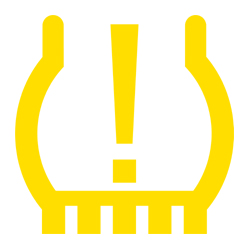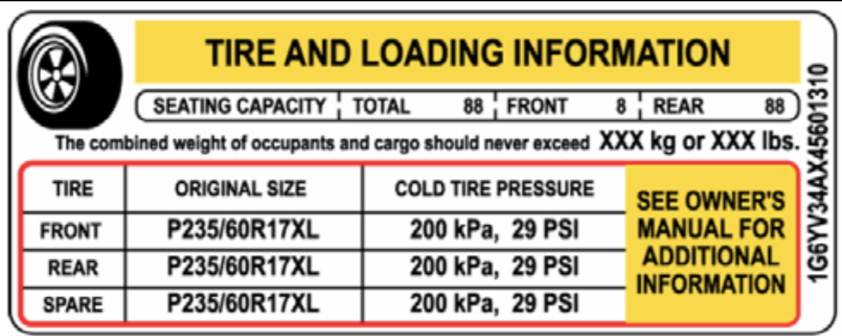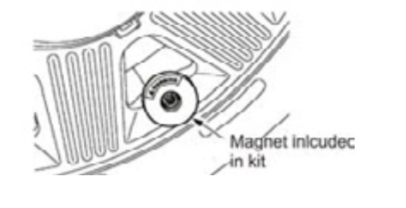Always test Before you touch!
Check for the TPMS Indicator
- Flashing Light = System Fault

- Solid Light = Low Pressure
- Flashing Light = System Fault
Always adjust pressure to placard
Always begin testing at LEFT FRONT
Always work CLOCKWISE around the vehicle
Refer to the VIN for the proper MODEL YEAR
The 10th character of the VIN indicates the proper model year. This is important as TPMS sensors and protocols change from year to year. [The following is from a 2003 model year]

Standard TPMS Placard

Testing magnet activated sensors
Early Corvette and Cadillac models used a magnet (included in kit) to activate the sensors.
- Set up tool

- Position tool on wheel
- Press Test
- Place magnet over stem
Testing “NON‐LF ACTIVATED” Sensors
Some vehicle manufacturers use sensors that have no LF wakeup. These sensors are activated by a change in pressure or ΔP.
- Set up tool
- Position tool on wheel (see below)
- Press Test (follow on screen instruction)
Sample TPMS Thresholds

Proper TPMS tool positioning

- Position the tool against side wall at sensor
- Aim the tool at the sensor
- Press to start activation
__ 4. Wait for beeping before moving the tool
__ 5. If no response, reposition tool and try again.
_ _6. Follow instructions on the tool display
FAQ
Technicians
If during the repair you cause a TPMS malfunction, or the light comes on after you’ve serviced a vehicle’s tires, YES you have to repair the vehicle.
No! This is why TEST BEFORE YOU TOUCH is so important. If the TPMS is faulty when it arrives at your shop, you are not required to fix it. However, it is good business to inform your customer and recommend that it be repaired.
Yes, you either sell new sensors for the additional wheel set and program them to the car, or take the OE sensors from their wheels and fit them to the new set.
You risk losing a customer. The dealer can service the vehicle, and in many cases sell them tires as well.
Invest in a tool, proper replacement inventory and get training. Understand that when the sensor battery fails, there will be a huge opportunity to service vehicles. Practice – practice – practice!
Consumers
It is a federally mandated safety system. It’s included when you buy the car, it protects your investment, and most importantly it keeps you safe!
Sensors are in each wheel. These sensors send information to you using a radio signal. When one or more of your tires go below an acceptable limit, you will get a light on your dashboard.
Your service provider has invested in the proper tools and training in order to properly and safely maintain your car. When rotating tires, or replacing TPMS Sensors, the car needs programming.
You will get a flashing light on your dashboard indicating a faulty system. Go to your service provider to get this repaired.
Generally the sensors only need servicing when replacing the tires. With every tire change, the mounting and sealing components should be changed to prevent leaks. With every tire service, the valve core and cap should be replaced to limit corrosion. Your service provider should have a TPMS Tool that checks the sensors condition.

